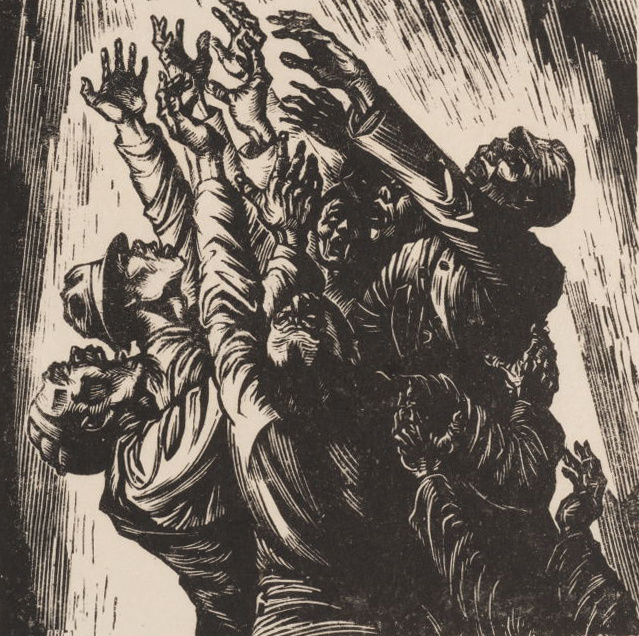For the first time, Colgate University’s Herman Collection of Modern Chinese Woodcuts, containing 209 printmaking pieces by Chinese artists, are housed in their entirety at the Picker Art Gallery located in the Dana Arts Center. The gallery hosted the “War, Revolution and the Heart of China, 1937-1948: The Herman Collection of Modern Chinese Woodcuts” exhibition opening reception on Thursday, Sept. 19 to showcase stories from the past in a new light.
Distinct time periods divide the exhibition into four sections, primarily based on times of war. Although the overall time period of the works ranges from 1937 to 1948, the content of the art still resonates today.
Co-Director of University Museums and Curator of the Picker Art Gallery Nick West gave remarks at the reception and acknowledged the darkness of the past that helped produce the art featured at the gallery.
“It is urgent that we consider the legacies of violence […] that bring us here today,” West said.
Student attendees like sophomore Lauren Pyon could sense the passion surrounding the exhibit shown by everyone involved.
“The atmosphere is very welcoming,” Pyon said.
West attributed the opening of the exhibition to the students involved with the exhibition, the curatorial staff, the installation team and many others.
Picker Curatorial Assistant and junior Taby Saour was part of the group of students who helped put together the exhibition. Saour first experienced exposure to Chinese woodblock prints during her freshman year at Colgate when she took the class HIST264A: Modern East Asia. She recognized the special opportunity to resume engagement with the works years later. Saour held an integral role in the opening.
“I also helped our curator [with] lighting, making sure that the light levels were in a good range because all of the pieces are light-sensitive, being paper,” Saour said.
Leslie Ann Eliet, who curated the exhibition, is the driving force behind this project. Eliet was previously the secretary registrar in 1979 at Picker.
Colgate came to house the collection when Professor Emeritus Theodore Herman acquired the pieces, who lived in China during the period these prints were made and acquired this collection alongside his wife Evelyn Mary Chen. Chinese artists Li Hua and Wang Renfeng gave him the pieces. Herman then taught at Colgate in the Geography Department. Of the 209 pieces located in Picker, 150 prints are from the Herman Collection.
“A box arrived from San Francisco, and I opened it up. I saw these prints, and I didn’t even know they existed,” Eliet said.
Thus began the further research that Eliet invested into the project of the exhibition opening and providing a forum for the telling of these stories.
Eliet met five of the artists in China, and she also visited two of the other three collections in Paris and London. The third collection is in Australia.
Eliet learned of Herman’s history with the works alongside his struggle to house them, partially due to anti-Communist sentiments spreading in the U.S. after his acquisition of the collection. Herman even lost a job during the Red Scare by association.
One remark that surfaced frequently in Eliet’s comments was the emphasis of storytelling, especially from a group of people whose stories are not as well known in the Western world.
The extent of the care dedicated to showcasing these stories conveyed the importance of recognizing the gallery’s role as a medium for artists’ voices.
“They tell stories that we’re just beginning to be aware of. They tell us a lot,” Eliet said.
These works show the perspectives of people experiencing the perpetuation of hardship during both the Second Sino-Japanese War having ended in 1945, and the civil war that broke out shortly after.
The prints depict many figures who appear emaciated and impoverished. Several works featured groups of people gathering for protests and demonstrations during times of political unrest.
Eliet believed that these artists wanted to educate Americans in particular.
“I think that was one of the artists’ goals: to educate Americans about the history. We tend to be very focused on American participation in World War II. We don’t really acknowledge that China had been fighting this war since 1937, long before the U.S. joined it,” Eliet said.
Not only does Herman’s experience with the Red Scare highlight the complicated relationship between the United States and China, but even the Chinese Exclusion Act of 1882 showed the struggle for control of the narrative.
“I think it’s great that they’re showcasing Asian art, which is something that wouldn’t come to mind being at a university museum or Colgate, so I’m glad that people are going to be able to see,” Saour said.
Eliet underscored the importance of people analyzing history for its truths, not stereotypes.
“It’s kind of a shame that we know so little about Asia in general and China in particular, especially now that the political rhetoric is so negative about China. I’m hoping that this [exhibition] will help people understand more about the real China,” Eliet said.

















